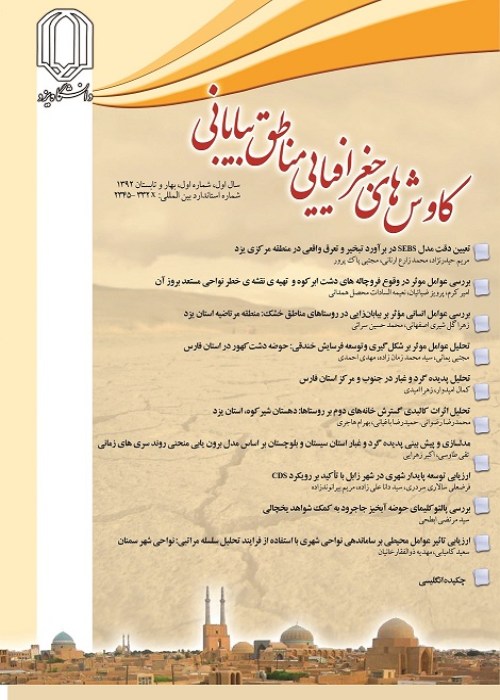Strategic assessment of reconstructing historical textures: A case study of District 2 of Kerman historical texture
Researcher studies show that most of the lands in this area, which has a population equivalent to the population of a neighborhood, are allocated to service uses, especially trans-local industrial uses that produce environmental and noise pollution and are not compatible with residential use. given. Since the mentioned land uses attract non-local population to this area, it reduces social security in urban spaces and as a result prevents the presence and continuation of indigenous residents in urban spaces and the formation of social interactions and explains the concept of neighborhood as a unit. Faces social cohesion in this area. On the other hand, the lack of an identifying public space, such as a neighborhood center that provides residents with cultural, commercial services, is also evident. The location of this area in the outskirts of the city and its proximity to the ring road, provides sufficient incentives to increase industrial land use and car repair in this area, which has caused significant barren lands in this area that if not controlled and Development guidance, there is an opportunity for the growth of such uses. The concentration of industrial and workshop uses (warehouses and repairs), especially in the western blocks and adjacent to Moftah Boulevard, which are inactive in night life, in addition to reducing night security for residents, has also reduced the vitality of the residential environment. On the other hand, the existence of trans-local uses incompatible with housing along with the lack or absence of cultural and recreational uses (parks, cultural centers and cultural centers and even mosques or reliance) that can meet the leisure needs of children, the elderly and young people, from One of the problems in this area is to improve the quality of life of its residents. In area 2 of the historical context, three main axes of activity (in Shahid Rajaei streets, Daneshjoo boulevard and Shahid Mofteh street) with an urban functional scale have created three strong physical and functional edges for the area. Although the buildings of the uses located in these activity axes have visual transparency and some of them occupy a part of the sidewalk space, but due to the unattractiveness of the uses in creating motivation for wandering and the continuation of pedestrian movement in the axis, a special type The pattern of purchasing and using the services of these uses (since the establishment of high-traffic uses for pedestrians are scattered along the axes, the reference is made in the form of short stops by vehicle), the mentioned axes lack vitality and It is a sign of the dynamism of the urban life of the inhabitants. According to the perceptions made in the second area of 1978, that is, equivalent to %67.84 of the buildings in the second area can be maintained. After that, restored buildings with 69 units and equal to % 95.2 percent and demolished buildings with 12 buildings and equivalent to %51.0 percent were in the second and third ranks. In terms of area, maintainable buildings with %44.68 in the first place and restored buildings with %17.2 and demolished buildings with %53.0 are in the next ranks. In the southern and eastern blocks of District 2, where the predominant use is residential and has parts with fine grain size and high occupancy level, the mass is dominant. But in the western and northern part of the basin, which often have industrial or workshop work, due to their low level of occupation, space is overrun. Components and important physical elements of the texture in the study area, a few elements such as the high school on the edge of Jihad Boulevard and the green space of the northeast corner of the area, are connected by a communication network within the texture, in a coherent network. In this area, the main north-south route due to its proximity to the industrial area also acts as a separator of the industrial sector in the western half and the residential sector in the eastern half of the texture and in addition to the road is important as a separating edge. In the study area of area 2, the streets surrounding the area, which are straight and arterial streets, have acted as an edge and have caused the separation of this area from other urban areas. The consecutive trees that can be seen along the path of some of these streets, including Shahid Rajaei Street, play an important role in defining these edges. Nodes in the study area have either been obtained from the accumulation of specific land uses or have been formed from the intersection of several important roads. One of these important nodes has been formed in the vicinity of Milad Noor Middle School. Among the mental signs at the level of District 2, we can mention the middle school and some of the industrial uses in it, especially in the western half of the district, as well as Laden Park, which is used from time to time. Lack of public open spaces, inadequate quality of roads, inadequate quality of buildings, existence of numerous abandoned spaces in the texture, is one of the most important physical problems in this area of the worn texture of Kerman. However, the existence of undeveloped lands and suitable land capacities in this area have provided suitable opportunities for the development of open and green spaces and the development of neighborhood services and the implementation of development stimulus projects in this area. In the framework of the ossification system of the area, a strong communication axis that traverses the length of the constituency and connects the belt axis to Daneshjoo Boulevard, connects the spatial physical elements (constituent elements of ossification) of the constituency like a rosary thread.
- حق عضویت دریافتی صرف حمایت از نشریات عضو و نگهداری، تکمیل و توسعه مگیران میشود.
- پرداخت حق اشتراک و دانلود مقالات اجازه بازنشر آن در سایر رسانههای چاپی و دیجیتال را به کاربر نمیدهد.



